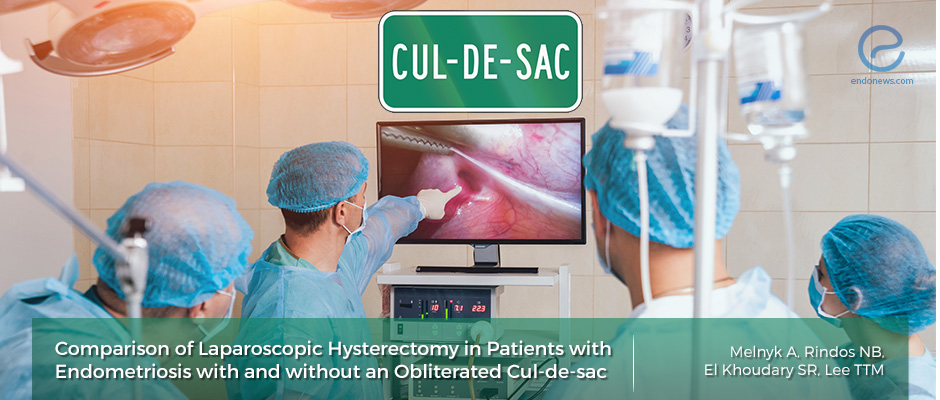Is there any difference between endometriosis patients with or without obliterated cul-de-sac during laparoscopic hysterectomy?
Oct 15, 2019
Patients with stage IV endometriosis and obliterated cul-de-sac should be managed by the surgeons experienced in minimally invasive gynecologic operations due to the difficulty of the surgery and the necessity of additional procedures.
Key Points
Highlights:
- Stage IV endometriosis with obliterated cul-de-sac differs from stage 4 endometriosis without obliterated cul-de-sac, and stages I through III in various aspects, during laparoscopic hysterectomy.
Importance:
- Patients with stage IV endometriosis with obliterated cul-de-sac require laparoscopic modified hysterectomy with additional procedures rather than a total laparoscopic hysterectomy or supracervical hysterectomy.
What’s done here?
- This retrospective cohort study was conducted at the University of Pittsburgh Medical Center, Magee-Women’s Hospital, Pittsburgh, from November 2012 through August 2016.
- Women who underwent hysterectomy due to several indications such as pelvic pain, abnormal vaginal bleeding, myomas, endometriosis and diagnosed with endometriosis intraoperatively were included.
- Hysterectomy was performed in 3 different ways: total laparoscopic hysterectomy, laparoscopic modified radical hysterectomy, and supracervical hysterectomy; the uterine artery was ligated at the level of the internal cervical os, performed by four experienced surgeons.
- Due to the retrospective design, stages were decided by scoring based on the operation note.
- The demographic and clinical characteristics and the necessity of additional procedures such as salpingectomy, ureterolysis, enterolysis, cystoscopy, ureteral stenting, proctoscopy, oversewing of the bowel, anterior resection anastomosis,.. were also evaluated.
- Patients were compared primarily regarding having stage IV endometriosis and stage I through III endometriosis. Secondarily, patients were sub-analyzed regarding the presence of obliterated cul-de-sac.
Key results:
- Laparoscopic hysterectomy was performed in 1069 women. A total of 333 patients were diagnosed with endometriosis (237 (71%) having stage I through III; 96 (29%) having stage IV endometriosis) were included in the study.
- Among patients with stage IV endometriosis, 55 patients (57%) had an obliterated cul-de-sac and 41 patients (43%) did not.
- According to the first analysis, there was a statistically significant difference between groups based on having anxiety, preoperative diagnosis, type of laparoscopic hysterectomy, operation time, the necessity of additional procedures, and estimated blood loss:
- Anxiety was more experienced in patients with stage IV endometriosis, these women underwent laparoscopic modified radical hysterectomy more frequently.
- They had also longer operation times and more estimated blood loss. Additional procedures were more frequently required.
- In the second analysis, statistically significant differences were detected between the groups regarding preoperative diagnosis, type of laparoscopic hysterectomy, operation time, the necessity of additional procedures, and estimated blood loss:
- Laparoscopic modified radical hysterectomy was performed more frequently in the patients with stage IV endometriosis with an obliterated cul-de-sac.
- They also had longer operation times and more estimated blood loss.
- There was no statistically significant difference between patients regarding postoperative readmission to the emergency room or the hospital and complications.
Limitations:
- The statistical significance level was not adjusted for multiple testing.
- These results were not generalized to all women with endometriosis, because these operations were performed by highly experienced surgeons.
- Besides this selection bias, there may be recall bias due to the retrospective design of the study.
- The scoring system which has not yet been standardized was used to classify the patients based on ASRM criteria. However, the depth of disease was not reported in operation notes.
Lay Summary
Endometriosis is a disease defined as the localization of endometrial glandular and stromal cells outside the uterine cavity. It is diagnosed in 10% to 15% of reproductive-aged women. Women with endometriosis demand therapy for the most common symptoms, which are pelvic pain and infertility. Medical or surgical treatment modalities can be suggested in the management of endometriosis.
Hysterectomy may be performed in women who desired complete relief of pain. Due to new technical developments, minimally invasive approaches are preferred in these women. All endometriotic implants should be excised during surgery to prevent the recurrence. However, recurrence risk increases as the stage of endometriosis progress.
Melnyk et al, a group of scientists from the United States, published a study entitled “Comparison of Laparoscopic Hysterectomy in Patients with Endometriosis with and without an Obliterated Cul-de-sac” in the journal named "The Journal of Minimally Invasive Gynecology".
These authors aimed to evaluate intraoperative and postoperative differences between patients having endometriosis with and without obliterated cul-de-sac. They also compared these patients regarding their demographic and clinical characteristics and stages of endometriosis according to American Society for Reproductive Medicine (ASRM) criteria.
Three different types of hysterectomy were total laparoscopic hysterectomy (removal of the uterus and cervix with ligation of the uterine arteries at the level of the internal cervical os), laparoscopic modified radical hysterectomy (removing the uterus and cervix and ligation of the uterine artery off of the origin of the internal iliac artery), and supracervical hysterectomy (removal of the uterus while leaving the cervix in situ; the uterine artery was ligated at the level of the internal cervical os).
They found that the patients with stage IV endometriosis with obliterated cul-de-sac had worse intraoperative findings and outcomes in comparison to those with stage IV endometriosis without obliterated cul-de-sac or stages I through III endometriosis. They had more blood loss and longer operation times. Laparoscopic modified radical hysterectomy and additional procedures such as salpingectomy, ureterolysis, enterolysis, cystoscopy, ureteral stenting, proctoscopy, oversewing of the bowel, anterior resection anastomosis were performed more frequently.
“Patients with obliterated cul-de-sacs who are identified intraoperatively should be referred to minimally invasive gynecologic specialists because of the difficult nature of these procedures and extra training required to perform them safely with limited morbidity,” they added.
Research Source: https://www.ncbi.nlm.nih.gov/pubmed/31279776
endometriosis stages of endometriosis ASRM criteria obliteration of cul-de-sac laparoscopic hysterectomy intraoperative findings complications

